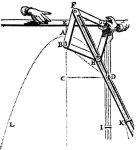In 1637, Rene Descartes published his famous La géométrie (one of three appendices to his Discours de la méthode–Discourse on the Method). We’ll probably discuss the ideas in Descartes’s work another time, but for now, it will suffice to say that La géométrie was a significant contribution to mathematics.
So why am I talking about Descartes when the title of this post is “Frans van Schooten”? Because without Frans van Schooten, Descartes’ work (originally written in French) might not have become as well known as it did. Not only did Van Schooten produce a Latin translation of La géométrie, but he also provided annotations to further explain and develop Cartesian geometry. Descartes’ ideas became widespread because of van Schooten’s work.
But van Schooten, a Dutch mathematician who lived from 1615 to 1660, made some contributions of his own as well. Since antiquity, geometric constructions had been necessary in mathematical proofs; that is, only if one could construct a solution using a compass and straightedge could one consider a problem solved. Descartes introduced the idea of using the other conic sections–parabolas, hyperbolas, and ellipses–in solutions of problems as well. This, however, produced a new problem: There was no mechanism for drawing these conic sections in a continuous motion. Descartes did not address this issue, but Frans van Schooten did.
In De organica conicarum sectionum in plano descriptione, tractatus, Van Schooten presented his designs for instruments to draw conic sections. Click on each thumbnail below for a larger image.
Here’s a GeoGebra applet of the parabola drawer.
Van Schooten’s conic section drawers can be a great way for your students to explore conic sections–for example, where are the focus and directrix in the parabola drawer? What is true about the point whose path is being traced? What happens if different elements in the instrument are moved?
These drawers can also be used to introduce the idea of finding a line tangent to a curve for beginning calculus students.
(I’d been considering this topic for a post here, but Sam Shah’s post about parabolas inspired me to go ahead and write it up.)


